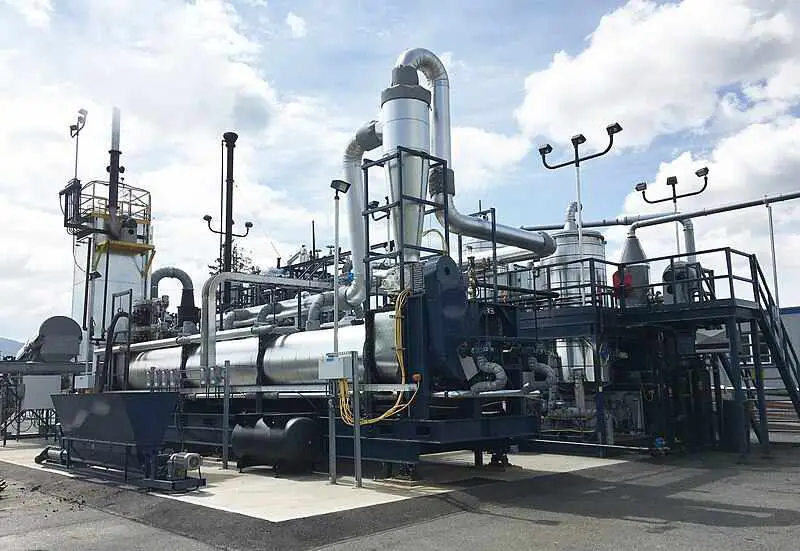9 Biomass Energy Disadvantages and Advantages Explained
Biomass energy disadvantages and advantages are; land allocation challenges, deforestation risk, gaseous missions, potential high cost, low relative energy density (disadvantages), geographic versatility, role in waste management, reduced fossil fuel dependence, multiple applications (advantages).
This article discusses biomass energy disadvantages and advantages, as follows;
-Biomass Energy Disadvantages
Biomass energy disadvantages are; land allocation challenges, deforestation risk, gaseous missions, potential high cost, low relative energy density.
1). Land Allocation Challenges (in Explanation of Biomass Energy Disadvantages and Advantages)
Challenges faced by biomass energy development efforts include the need for vast expanses of land to cultivate plants that will be used as biomass feedstock [3].
Two problems with bioenergy and biofuel production within the context of land resources, are the competition with food production as a more important form of land-use, and the risk of degradation of land in the form of water and nutrient depletion.
Large-scale cultivation of biomass affects land by depleting soil nutrients, consuming water resources and reducing water quality [9]. While the occurrence and severity of these environmental impacts may vary with location, they generally reduce the appeal of biomass as a source of renewable energy.
The extensive demand for land resources to cultivate biomass feedstock can make it impossible to rely on biomass itself as an energy resource, especially in areas where land resources are strained due to urbanization, overpopulation, or food insecurity among other factors.

2). Deforestation Risk
One of the dangers of biomass energy arises from its dependence on vegetation as an energy resource. This is also one of the most potent points in the argument that biomass energy is bad for the environment, since vegetation plays a crucial role in oxygen supply, soil conservation, air quality enhancement, and water conservation.
Development of biomass energy leads to deforestation when the rate of removal and consumption of plant biomass, exceeds the rate at which it is replaced.
In fact, such an outcome is not difficult to achieve in most parts of the world, given the rate if urbanization and industrialization, and the lack of sufficient input in terms of fiscal investment and policy-implementation, to ensure that depleted forests are regenerated.
Any form of deforestation can have major ripple effects for the ecosystem, because forests serve as a natural carbon sink for reducing harmful atmospheric emissions, increasing carbon sequestration, and mitigating regional air pollution [1].
3). Gaseous Emissions (in Explanation of Biomass Energy Disadvantages and Advantages)
In spite of being a renewable form of energy, biomass energy is not entirely clean.
Biomass energy produces emissions of both greenhouse gases and other harmful gaseous contaminants.
Greenhouse gases emitted from the burning of biofuel include; carbon dioxide (CO2), sulfur dioxide (SO2), carbon monoxide (CO), and nitrogen oxides (NOx). Other harmful materials emitted are; mercury, lead, and particulate matter.
The potential of biomass energy to cause harmful emissions is often disputed based on the fact that biomass is carbon neutral; which means that plants absorb as much CO2 and other gaseous elements during they growth, as they emit when they break down through combustion or biodegradation.
While this is true, it can only be put to effect where there is conscious and consistent effort to replace biomass that has been burnt as fuel, and this is not often the case in reality.
It must still be noted that the emissions from biomass combustion are significantly less than those from fossil fuels like coal and petroleum [4].
Also, unlike most fossil fuels, biomass energy can be developed in a sustainable manner to minimize its net emissions.
4). Potential High Cost
Generally, biomass is inexpensive compared to fossil fuels as an energy source.
However, the capital cost of biomass energy development is relatively high, as a result of various factors that include the technological complexity and diversity of bioenergy systems, and the fact that biomass energy is still in its developmental stage and has not been fully subsidized.
The exact costs of biomass energy depend on the type of system being installed, the scale of operations, and the intended output in terms of amount of electricity and performance of systems.
For example, anaerobic digesters may cost different from pyrolytic reactors and gasifiers, and all of these may cost much less than a large-scale integrated biorefinery.
Another factor that inflates the cost of biomass energy at the capital investment stage is the need for large expanses of land, labor, and a consistent supply of sufficient biomass.
In general, the capital cost of biomass energy power plants ranges from $500 to over $6,000 per kW. This range is based on expenditures in actual bioenergy projects in developed and developing countries since the beginning of the twenty first century.
The lower end of this range ($500-900) is only attainable in low-income areas, such as the rural parts of developing countries like Indonesia [8].
At the point of electricity generation itself, biomass energy can produce power at relatively-low levelized costs of less than $1.0 per kW. However, the required capital and the need for return on investment can be a deterrent to developing biomass energy.
5). Low Relative Energy Density (in Explanation of Biomass Energy Disadvantages and Advantages)
Biomass has low energy density per kilogram compared to other energy sources like fossil fuel and nuclear radioisotopes.
The energy density of biomass in MJ/kg lies between 17 and 20, where the higher values can be found in high quality woody biomass, and the lower values are typically associated with organic waste.
Because of its low energy density, the processing, storage and transport of biomass is relatively expensive, since its energy per unit mass is not always sufficient to cover its handling costs effectively.
Biomass supply is also affected by seasonality, and this further reduces its reliability for energy production.
-Biomass Energy Advantages
Biomass energy advantages are; geographic versatility, role in waste management, reduced fossil fuel dependence, multiple applications.
1). Geographic Versatility (in Explanation of Biomass Energy Disadvantages and Advantages)
Biomass is considered a versatile renewable energy source for two reasons; the first of these being its wide geographic distribution, and the second being its applicability for multiple purposes.
Geographic versatility here is used to refer to the fact that biomass as an energy source can be produced locally in nearly all parts of the world; so that the only zones that are incapable of producing sufficient biomass as those affected by desertification or extreme cold climate.
In fact, the supply of biomass in some regions is abundant enough to make it the most-used energy resource after petroleum [5].
Regions that produce biomass abundantly can use it to reduce the environmental impact of their energy sector, by effectively regenerating consumed feedstock [7].
2). Role in Waste Management
Biomass-waste energy is simply biomass energy that is derived from organic waste.
The existence of organic waste in all human-occupied parts of the world indicates that biomass energy development can play the role of waste management for such materials.
Combining renewable energy production to waste management makes biomass energy not only environmentally beneficial in multiple ways, but also a useful tool for sustainable development, through the control of water, soil and air pollution, and improvement of life-quality [6].
The major types of biomass waste include; forest residue, industrial and municipal organic wastes, and agricultural waste [10].
Converting waste-to-energy for bioenergy production can go a long way in diverting organic materials from landfills and other disposal facilities, thereby making these facilities easier to manage and safer for the environment.
3). Reduced Fossil Fuel Dependence (in Explanation of Biomass Energy Disadvantages and Advantages)
Biomass and fossil fuels are related in the sense that they both come from organic sources and processes.
When compared, both energy resources have advantages and disadvantages which make each one peculiar with respect to the other.
The advantage which biomass has over fossil fuels is its renewable nature, combined with its geographic versatility; both of which imply that it can be produced more widely and abundantly than fossil fuels.
In fact, biomass energy development can help to reduce the extent to which we depend on fossil fuels tor energy, by providing an alternative which can be produced and utilized locally.
The disadvantage which biomass shares with fossil fuels is the gaseous emissions produced by both materials, although biomass emissions are lower in volume and can be mitigated more effectively than fossil fuel emissions.
Biomass is unable to totally replace fossil fuels in the energy transition scheme, because it is not as efficient as fossil fuels. The relative low energy efficiency of biomass comes from a lower output per unit mass, which reduces the amount of net energy gained after that which is expended in transport and processing are subtracted.

4). Multiple Applications
Biomass has multiple uses as an energy resource. This is an advantage which further emphasizes the fact that biomass energy is versatile.
The various applications of biomass energy are electricity generation, heating, and backup through energy storage.
Also, these applications are interrelated and can easily transit from one to another, which makes biomass energy usage flexible. For example, thermal energy from the combustion of solid biomass (like wood) can be used directly to generate electricity with a steam generator and turbine.
Biomass can be converted to biofuel or biogas by any of various biomass-conversion methods including; gasification, pyrolysis and anaerobic digestion [2].
Types of biomass feedstock include wood, municipal organic waste and sawdust.
Aside combustion, biomass can also be used to produce renewable fuel in the form of green hydrogen. This fuel can yield hydrogen energy when electrolyzed in a fuel cell. Such instances are indicative of the flexibility of biomass energy.
Conclusion
Biomass energy disadvantages and advantages are;
1. Land Allocation Challenges
2. Deforestation Risk
3. Gaseous Emissions
4. Potential High Cost
5. Low Relative Energy Density (Disadvantages)
6. Geographic Versatility
7. Role in Waste Management
8. Reduced Fossil Fuel Dependence
9. Multiple Applications (Advantages)
References
1). Hall, D. O.; House, J. I. (1994). "Trees and biomass energy: Carbon storage and/or fossil fuel substitution?" Biomass and Bioenergy, Volume 6, Issues 1–2, 1994, Pages 11-30. Available at: https://www.sciencedirect.com/science/article/abs/pii/0961953494900817. (Accessed 25 February 2023).
2). Kumar, A.; Bhattacharya, T.; Hasnain, S. M. M.; Nayak, A. K.; Hasnain, S. (2020). "Applications of biomass-derived materials for energy production, conversion, and storage." Materials Science for Energy Technologies. Available at: https://doi.org/10.1016/j.mset.2020.10.012. (Accessed 26 February 2023).
3). Ladan, S. (2017). "THE CHALLENGES AND PROSPECTS OF USING BIOMASS ENERGY IN NIGERIA." 1ST NATIONAL CONFERENCE ON CHEMICAL TECHNOLOGYAt: NATIONAL RESEARCH INSTITUTE FOR CHEMICAL TECHNOLOGY (NARICT) BASAWA,ZARIA KADUNA STATE NIGERIA. Available at: https://www.researchgate.net/publication/319044101_THE_CHALLENGES_AND_PROSPECTS_OF_USING_BIOMASS_ENERGY_IN_NIGERIA. (Accessed 25 February 2023).
4). Laryea-Goldsmith, R.; Oakey, J.; Simms, N. J. (2011). "Gaseous emissions during concurrent combustion of biomass and non-recyclable municipal solid waste." Chem Cent J. 2011 Feb 1;5:4. Available at: https://doi.org/10.1186/1752-153X-5-4. (Accessed 26 February 2023).
5). Longhurst, P. J.; Gift-Onyesoh, J. B.; Manovic, V. (2016). "Biomass resources and biofuels potential for the production of transportation fuels in Nigeria." Renewable and Sustainable Energy Reviews 2016(63):172-179. Available at: https://doi.org/10.1016/j.rser.2016.05.050. (Accessed 26 February 2023).
6). Omer, A. M. (2012). "Biomass energy resources utilisation and waste management." Agricultural Sciences 03(01). Available at: https://doi.org/10.4236/as.2012.31016. (Accessed 26 February 2023).
7). Singh, J.; Panesar, B. S.; Sharma, S. K. (2008). "Energy potential through agricultural biomass using geographical information system—A case study of Punjab." Biomass and Bioenergy, Volume 32, Issue 4, April 2008, Pages 301-307. Available at: https://www.semanticscholar.org/paper/Energy-potential-through-agricultural-biomass-using-Singh-Panesar/0e785f9886f129415383b62a296cc3780b301c8d. (Accessed 26 February 2023).
8). Susanto, H.; Suria, T.; Pranolo, S. H. (2018). "Economic analysis of biomass gasification for generating electricity in rural areas in Indonesia." IOP Conference Series Materials Science and Engineering 334(1):012012. Available at: https://doi.org/10.1088/1757-899X/334/1/012012. (Accessed 26 February 2023).
9). Trimble, J. L.; Van Hook, R. I.; Folger, G. A. (1984). "Biomass for energy: the environmental issues." Biomass, Volume 6, Issues 1–2, 1984, Pages 3-13. Available at: https://www.sciencedirect.com/science/article/abs/pii/0144456584900039. (Accessed 25 February 2023).
10). Zhou, C.; Wang, Y. (2020). "Recent progress in the conversion of biomass wastes into functional materials for value-added applications." Sci Technol Adv Mater. 2020 Dec 14;21(1):787-804. Available at: https://doi.org/10.1080/14686996.2020.1848213. (Accessed 26 February 2023).




